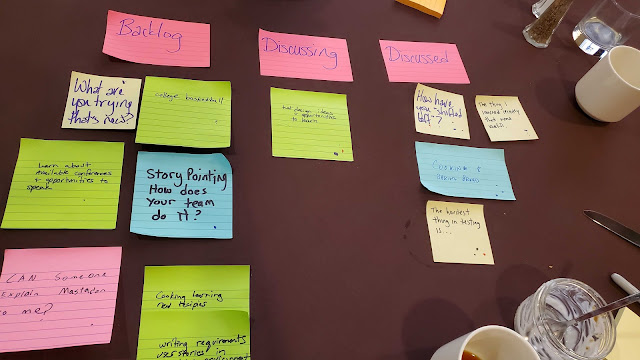Lean Coffee? Over breakfast? With bacon? At CAST 2022? Yes please! Here's my aggregated notes from that early morning munch'n'chat with a bunch of dedicated testers and also some bakers.
How have you shifted left?
One of the ways I've used is to ask developers to write test notes with each story.
It worked well once I'd persuaded one and he advocated for it to the others.
If there are no notes on the story, I'll initiate a conversation about risk.
We have an Amigos session early in development.
We identify things to test with the story.
Someone on the team picks that task up ...
... and it's usually me or the developer that did the coding.
They are supposed to write notes, but the quality is pretty variable.
I am shifting left by doing it.
I will initiate conversations with people who matter at any time.
I show value so that people are interested in working with me next time.
At my place I ask to be invited to conversations.
This has been successful, except that staff changes mean I have to keep on asking,
I shift left by looking to prevent defects through question-asking.
Also, don't let developers write the requirements (!)
Cooking and baking bread
I got into sourdough during the pandemic.
I'd make a loaf every few days.
My kids have picked the habit up now too.
I have had a bread machine since before it was fashionable!
My only problem is that you need to think about using it three hours before you're hungry!
Homemade bread and hummus, yum!
I think making your own bread needs too much investment.
My daughter is coeliac and my wife makes this amazing rolls for her with special flour.
Are allergies and intolerances more common now?
In the past people just cared less about other people's suffering.
The hardest thing in testing is ...
Phew, complacency.
Getting into a rut doing the same kinds of things all the time ...
... but Dawn Haynes' tutorial yesterday helped with test idea generation.
Arguing with developers gets old.
"This is what the requirements say"
"Yeah, but why? And why not this instead?"
We should know and share the expected business value.
The absurd feeling of responsibility for the team's work.
People trusting and expecting testers to be the last line of defence.
Telling the testing narrative over and over to management.
"How many test cases do we have?" Aaaaarrrgghhh!
I left a job because I wouldn't fit into that kind of culture.
People are the hardest thing.
I am not a people person. I would love to sit in a box and have software passed in ...
... and I'll pass test results out.
That feeling of having missed something,
Getting to a point where you're satisfied with the coverage.
The thing I learned recently that was useful was ...
Model-based testing.
That I need to stop being so experienced and let my inner newbie guide me sometimes.
All-pairs testing.
In a small company you need to wear many hats, such as sales.
But watching an expert salesperson really sell something is illuminating.
They sell a collaboration, not a service.
Having seen that we now ask testers to do the same.
Finding opportunities to learn
How do you all find the time and opportunity to learn, especially for test design?
CAST!
Elisabeth Hendrickson's cheat sheet. (Which is rolled into this MoT sheet.)
Lena Wiberg's Would Heu-Risk It cards, or TestSphere.
Podcasts.
Working with others, e.g. pair testing with someone from another team.
Teaching others how to test.
You see things through their eyes.
Making test notes public - people sometimes identify stuff I've missed or got wrong.

